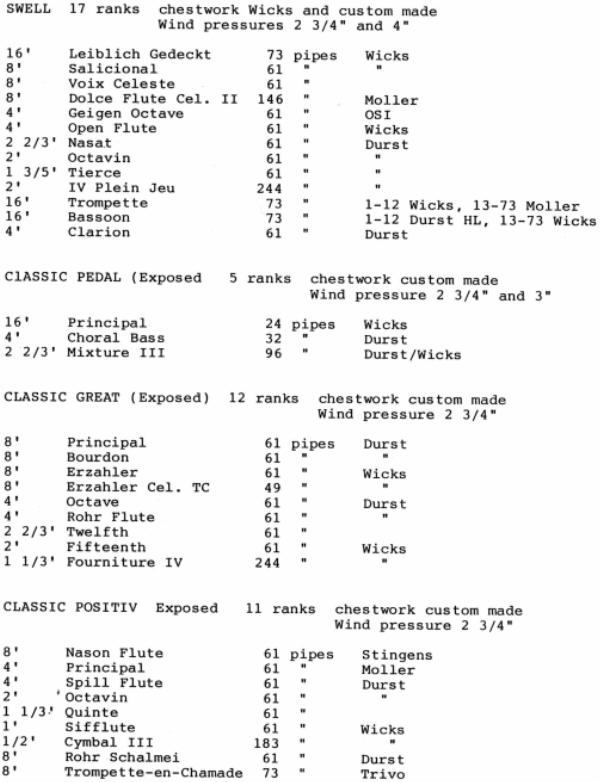William J. Mollema's 4-82 Residence Installation, Scotts, MI

Mollema and Console

What a beautiful organ. We'll tell the story in his own words. Enjoy pictures of this marvelous instrument as you read about it.
From the beginnings of my infatuation with the pipe organ, some 43 years ago at the age of 13; I wanted someday to have an instrument of my own. The 1950ís was a period when it was very difficult for hobbyists to gain access to organs. Theatres (those which still had instruments) were very protective and suspicious of anyone expressing an interest in the organs, and churches always kept their instruments locked up; I presumed at the time because organists must be terribly insecure about their jobs!
During my teen years, my parents put up with a small 9 rank organ in our basement. This organ, which I put together out of scrounged up parts, was not very theatrical, but it did satisfy my needs at the time. Then the college years came along and after that my employment with WICKS as the area representative. During this period in my life, from 1961 through the early 80ís I was fortunate to have access to the organ in a local theatre, which, along with a very close friend and fellow enthusiast, we restored and played regularly.
In 1976 I installed a new instrument in a church which had a very unusual design. The building was basically a cross of two symmetrical, flat topped A frames; and I was struck by the plan and felt that a down-sized version of this design would make a really neat home. More importantly, it would be house that would lend itself to a pipe organ installation. I immediately set out to design my dream home and in the early summer of 1976 began construction after acquiring 20 acres of property in the country on which to build. With the exception of the poured concrete basement walls, I was determined to do all of the building myself. Besides enjoying this type of work, I reasoned that I could better control the quality of the construction and the necessary allowances for my dream instrument. Progress was steady but slow and finally on July 4 of 1978 I moved into the house with only insulation showing on the inside and a sort of operating kitchen and bathroom! Work continue on the house, landscaping and other projects until the late 1980ís; all the while collecting and storing away organ parts for the eventual dream instrument.


Upper Foundation String ( Clarinet and Vox behind)

Main Chamber Back -Front Krumet,Quintadena,VDO Cel,T. Horn,VDO,Post
Horn,Vox,Oboe Horn, Tibia, Ophicleide
By the time a specification had been conceived and put down on paper, I realized that I would never find a console of sufficient size with which to control this organ. As a result of this realization, I designed and built my own 4 manual console in my workshop. It was my desire that the console be ďuser friendlyĒ - a console at which both theatre style organists and classic oriented organists could easily feel at home. Although the console is constructed in the theatre style; it can still easily be managed by the classical musician since those stops are grouped together in a standard arrangement rather than being mixed in with the theatre voices. Aside from sharing keyboards and couplers, the arrangement is really like two consoles in one. The triple bolsters and traditional backrail control the theatre instrument; the fourth partial bolster below the full triple bolsters and above the backrail controls the classic instrument. While there are 8 general pistons which control only the classic organ; the regular divisional and general pistons totaling 90 control the entire organís resources.
 Positiv Center and right is Positiv pipework, left is Pedal 4' C. Bass
and IV Mix
Positiv Center and right is Positiv pipework, left is Pedal 4' C. Bass
and IV Mix



Great and Pedal in front of chambers

Great and Pedal in front of chambers
What is most important, however, is that the organ is very easy to listen to as it speaks into an acoustically warm room which, because of the open design of the house, is actually the entire first and second floors of the house. While the primary listening area is the 22í X 60í livingroom, the loft bedrooms as well as the study and dining area all play a part in the acoustical setting for the instrument. Even though the ceiling height of the livingroom is 17í, the angular walls create a warm, controlled presence without any cold, barn-like echo.



Swell lower level l-r F.Overt, O.Flt, Sal., V.Cel., St. Flute, F.Overt
Celeste

Lower Solo right side l-r Musette, Brass Sax., Brass Trum, "Ball Bat"
Kinura
As many of the members of ATOS know from their own experience, it is immensely satisfying to create an instrument of any size and then be able to realize the added pleasure of playing it!
Put your organ online FREE at Theatreorgans.com Email the Webmaster for more information!
TheatreOrgans.com operates KEZL-FM Culbertson, NE A Non Profit Full Powered Radio Station